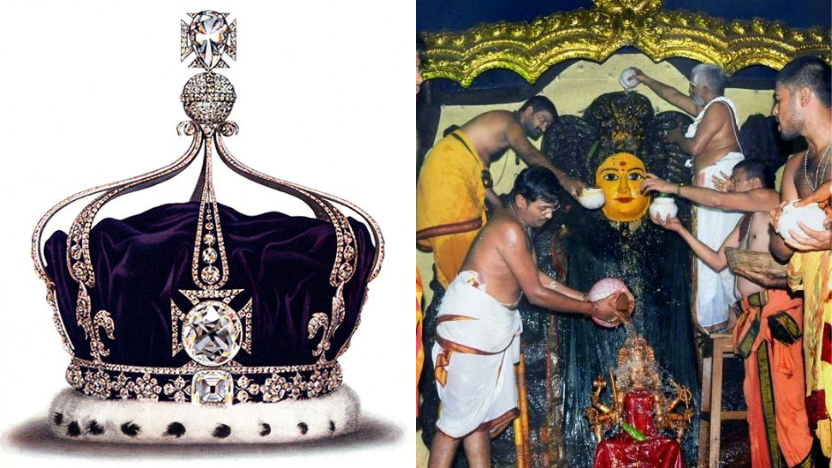The Koh-i-Noor, meaning “Mountain of Light” in Persian, is one of the most renowned diamonds in the world. Originally believed to have been installed as the left eye of Goddess Bhadrakali in Warangal, India, the diamond has a complex and contested history that spans dynasties, empires, and continents.
The Koh-i-Noor is believed to have been mined from the famed Kollur Mine (also known as Coulour or Gani mine) in present-day Guntur District, Andhra Pradesh, India. The Kakatiya dynasty, which ruled large parts of Telugu-speaking regions between 1083 CE and 1323 CE with their capital at Orugallu (now Warangal), is among the earliest known possessors of the gem.
King Pulakesi II of the Chalukya dynasty is credited with constructing the Bhadrakali Temple around 625 AD, commemorating his victory over the Vengi region. The Kakatiyas later adopted Goddess Bhadrakali as their family deity and are said to have enshrined the Koh-i-Noor as her left eye.

In 1323, Ulugh Khan, a general under the Tughlaq dynasty, led a second, successful invasion of the Kakatiya kingdom, seizing the diamond among other treasures. Thereafter, the diamond passed through the hands of the Tughlaqs, the Lodi dynasty, and eventually came into the possession of Babur in 1526 following the establishment of the Mughal Empire. Babur referred to it as the “Diamond of Babur” in his memoirs.
Successive Mughal rulers ; Humayun, Akbar, Jahangir, Shah Jahan, and Aurangzeb, kept the gem in the imperial treasury. Shah Jahan had it set in the opulent Peacock Throne, while Aurangzeb later moved it to Lahore. Under Aurangzeb's rule, the diamond was cut by Venetian lapidary Hortenso Borgia, reducing its weight from 793 to 186 carats.
In 1739, Nader Shah of Persia invaded Delhi and took the Peacock Throne and the diamond. It is said that upon acquiring the gem, he exclaimed “Koh-i-Noor,” giving the diamond its now-iconic name. Nader Shah's assassination in 1747 led to the diamond being inherited by his general, Ahmad Shah Durrani, founder of the Afghan Durrani Empire.
In 1813, Shuja Shah Durrani, the deposed Afghan ruler, took refuge in Lahore with the diamond. Maharaja Ranjit Singh of the Sikh Empire accepted the gem in exchange for protection. On his deathbed in 1839, Ranjit Singh wished to donate the diamond to the Jagannath Temple in Puri, Odisha, but his will was not honoured by British administrators.
After the annexation of Punjab in 1849, the British East India Company claimed the Koh-i-Noor under the Treaty of Lahore. In 1850, the gem was transported to England and presented to Queen Victoria by Ranjit Singh’s young successor, Duleep Singh. It was later re-cut and set in Queen Victoria's crown.
The Curse of the Koh-i-Noor
The diamond is reputed to carry a deadly curse for male owners. An ancient text from 1306 states, “Only God or a woman can wear it with impunity.” All known male possessors of the diamond, across dynasties, either died prematurely or faced tragic ends. Queen Victoria and subsequent British queens, however, remained unharmed. Still, the Koh-i-Noor has not been worn by Queen Camilla, reportedly due to lingering superstitions.
Some speculate that the Koh-i-Noor could be linked to the legendary Syamantaka Mani, described in the Vishnu Purana and Bhagavata Purana. The gem, originally gifted to Satrajit by the Sun God, was believed to produce gold daily and was associated with multiple deaths and calamities. While intriguing, historical records do not confirm a direct connection between the Koh-i-Noor and the mythical Syamantaka Mani.
The Koh-i-Noor has long been a point of contention between India and the United Kingdom. The first official request for its return came soon after India’s independence in 1947. Since then, multiple appeals ; including during Queen Elizabeth II’s 1953 coronation and her 1997 visit to India have been made.
In 2000, Indian parliamentarians reiterated that the gem had been unlawfully taken. The demand resurfaced during British Prime Minister David Cameron’s 2013 visit, yet the UK has maintained that the diamond was acquired legally under the terms of the Treaty of Lahore.
Today, the Koh-i-Noor remains part of the British Crown Jewels, displayed at the Tower of London, its rightful ownership still fiercely debated.
Source / Image Credit : BooksFact, hinduism and sanatan dharma







